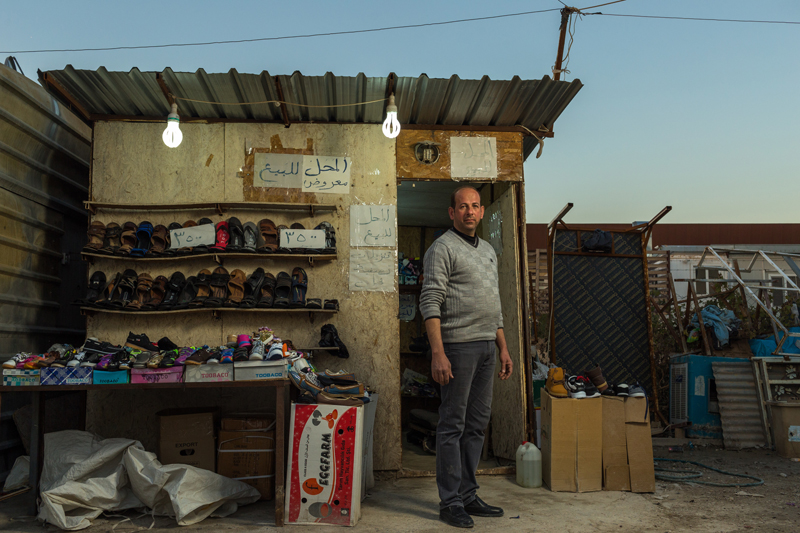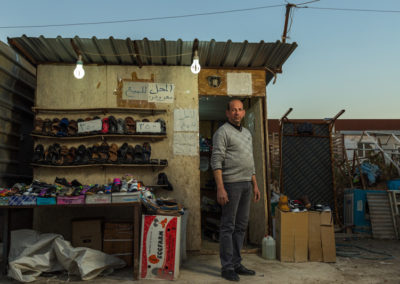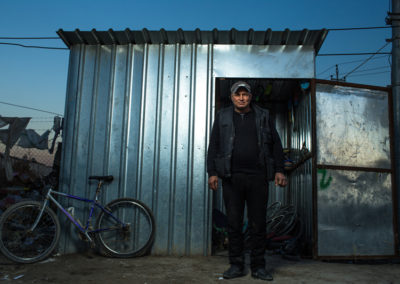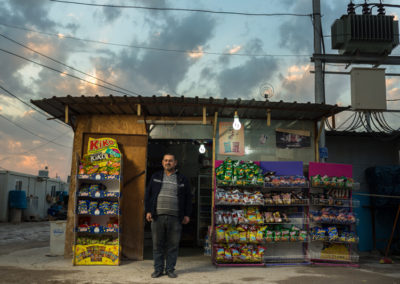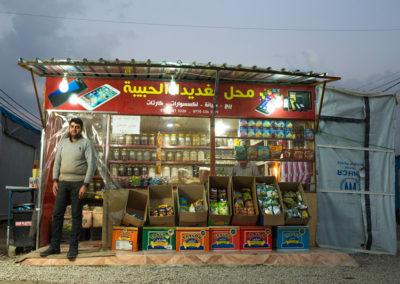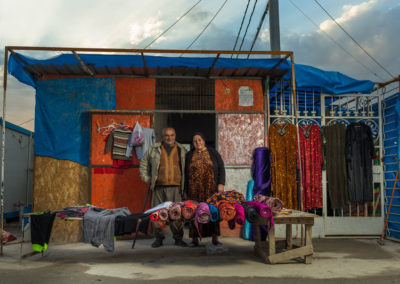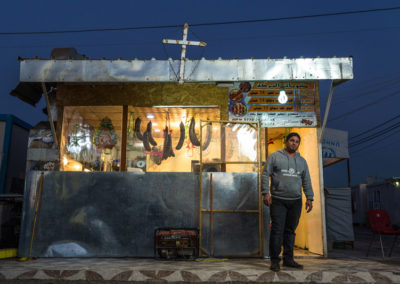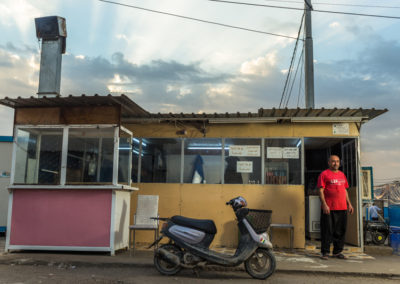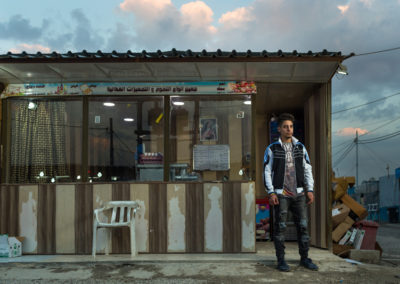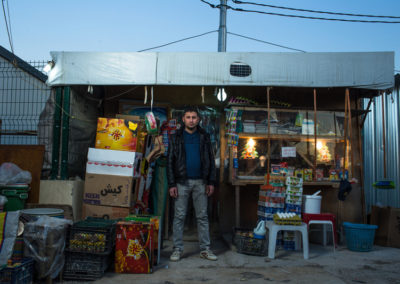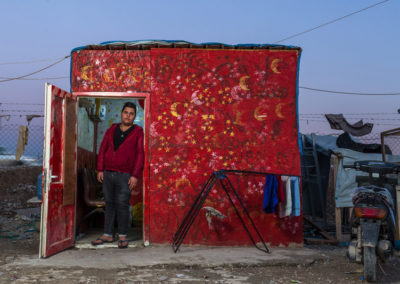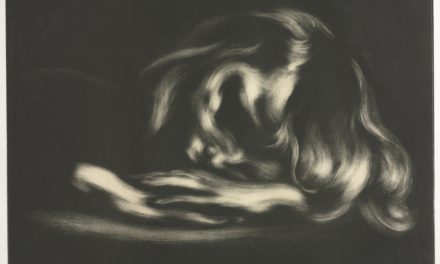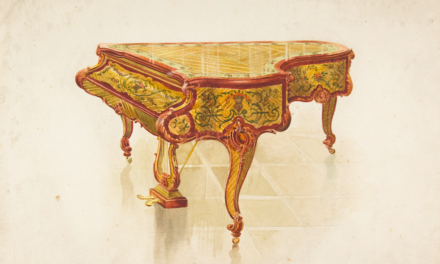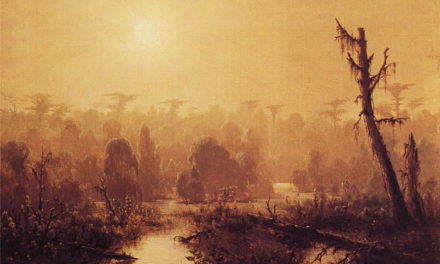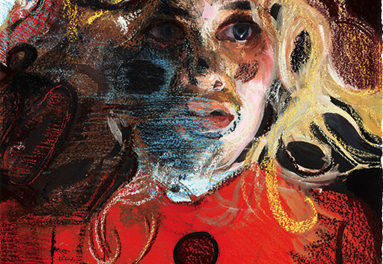Shop Owners
photography by João Castellano
Interview by Lucía Seda-Pérez
For our spring 2018 issue, The Capra Review is honored to showcase the work of the Brazilian photographer, João Castellano. Between 2016 and 2017, Castellano spent six months in Iraq photographing the conflict against the Islamic State. During that time he visited Ankawa 2, a camp for internally displaced people run by the Assyrian Catholic Church in the city of Erbil in Kurdistan, an autonomous region in northern Iraq.
Since 2014, the camp has welcomed roughly 1,200 families and 5,000 individuals, many of whom fled Qaraqosh, Iraq’s largest Christian city, when the Islamic State invaded the region. For the series “Shop Owners,” Castellano photographed residents at Ankawa 2 who were given the opportunity and materials to build and open their own small businesses, free of charge.
We spoke with Castellano about the genesis of the project, his main takeaways and the images of the Middle East in mainstream media outlets.
Salam
SHOE SHOP Salam Toma, 42, has worked with shoes all of his life—first in Baghdad and later in Qaraqosh. He plans to emigrate to Australia with his family.
Abd
BIKE REPAIR SHOP Abd Behnam, 49, owned a farm in Qaraqosh. His business in the camp is not profitable, but it is a nice way for him to interact with other people.
Amir
SNACK SHOP Amir Hamocan Polece, 61, has lived in the camp since 2014. Back in Qaraqosh, he used to work in an aluminum factory. He opened this shop to pass the time.
Anwar
SPICES AND NUTS SHOP Anwar Salam Aziz, 39, has been selling spices and nuts since he was 10. His family owned similar shops in Baghdad.
Benjamen_Sabria
TEXTILES AND CLOTHING Benjamen Hamocan Polece, 62, and Sabria Wadea, 55, owners. In Qaraqosh, Benjamen worked at a diesel generator plant.
Bhnam
RESTAURANT Bhnam Hana, 30, began working in restaurants at 13, and opened his first restaurant when he was 18.
Nashwan
KEBAB RESTAURANT Nashwan Abada, 46, owned several kebab shops in Qaraqosh. He doesn’t want to leave Iraq.
Revan
BUTCHER Revan Manar Behnam, 17, has been running the shop with his father and uncle for one year. In Qaraqosh, his father used to work as a driver.
Saad
GROCERY Saad Waad, 25, owned a chicken farm and lost everything when he and his family fled Qaraqosh. He invested around $4,500 in this shop.
What prompted your interest in documenting the stories of these shop owners?
The idea came from a conversation with my girlfriend, who used to be a photo editor at the Brazilian edition of National Geographic. She joined me in Iraq after I had been there covering the conflict for two months. At the time she arrived, a colleague and I were working on a story about Christians in Iraq, and the three of us spent Christmas Eve in Anakawa 2, the Christians-displaced camp in Erbil. When she saw the shops inside the camp, she told me that [it] was a story worth photographing. But I was more interested in documenting the frontline – as this had been one of my dreams since I began shooting. Also, I wanted to try something different from what I used to do in Brazil, which was mostly portraits. Eventually, I did some tests one afternoon and was excited with the possibility of depicting a particular side of the war no one else was talking much about.
Beyond profits, what do you think that shop owners gain from this opportunity to sell their products?
In the interviews, most of them said the businesses were more a way of spending the time than of making a lot of money. I believe their biggest gain is the feeling that life is going on. I see the shops as a way they found to try to bring normality back to their lives. These people lost everything they had. Having an activity is one attempt to begin rebuilding their lives from zero, and also to set an example for the community.
How would characterize the relationship between the families living in the camps and the surrounding Christian neighborhood? More specifically, what role, if any, do the shops play in facilitating integration?
Contrary to other camps in the Nineveh region, this is open, so people can come and go out freely, which helps integrate. Some of the barbers mentioned they had occasional customers from outside the camp, but the same does not apply to other businesses, as the shops inside are a small version of what you find outside. Some families have split; a part lives in the camp, another outside, in the Christian neighborhood of Ankawa. It depends on the economic situation – if the family has some money they can afford to pay rent outside. But all of them are suffering because they had to abandon their hometown and leave everything behind.
In this project, the colors of the storefronts create a striking contrast with the grey backdrop. Was this an intentional stylistic choice?
The colors in my photographs have come to define my style, but they are not always intentional. In fact, they are a consequence of the use I make of flash. In “Sou Farofa”, the project I did on beachgoers in Brazil, I had to close my f-stop in order to use the flash. So, the colors came out more vibrant. In the case of the shop owners, I couldn’t get as close to the subjects because I wanted to show the shops. I had to photograph them at the end of the day, so my flash could be more distant from the owners, making the skyline gray. But what really drives my work are the people I am photographing; I adapt my technique and my photograph to each case
What did this experience of being with the shop owners and seeing what they’re doing teach you about photography? Did you learn anything new or see things differently after having done this project?
People will ask me how my experience was in Iraq and I tell them that my experience doesn’t matter because it’s very small [compared to] what those people live. Nobody asks me what their lives are like. What it taught me the most was that photography is a part of life. The camera, the photographer is just an instrument to capture the reality and the interactions you have with people, the relationship you have with others. As a human being, it taught me that we all have our issues and we have to look to others and show what people don’t want to show. I think that the [news] industry is corrupted. The media outlets always want to show the same thing. They all want the blood, the action, the suffering. You don’t see many people doing what I did when I was there. They want the “big picture.”
The picture of conflict and bloodshed and death.
There were so many journalists—and I couldn’t sell my pictures. I did one series, “Dreams.” I photographed kids in a camp and asked them what their dreams were. I couldn’t sell that project. It was exhibited in a museum in Brazil. I offered to sell the series $1,000 to a newspaper and they didn’t want to pay for it. I said [to the newspaper editor] “If I have a photograph of a car bomb exploding, or an ISIS guy cutting off someone’s head, you would pay me $10,000.” Even this project I managed to publish in one outlet only, and now in the Capra Review.
It’s almost as though journalism doesn’t see a news angle and then you’re forced to present your work as art. And it is art, but it is newsworthy, too.
Capitalism makes us not pay attention to the Middle East, the way I see it. We are taught to see the people there as less than us. When the attack in Paris happened, we put avatars and tags with “I love Paris,” [on social media] but we have one attack per week in the Middle East. You don’t see people putting avatars. Why? Because when the news talks about the Middle East, they use the word “terrorists.” The big lesson for me is that war is an industry of money. It’s a business. People don’t care about other people.
And your experience has shown you that those pictures of car bombings and attacks sell better than a series of pictures of encounters with people at a camp.
It was my dream for me to go to a war because I wanted to do those pictures, the “big” pictures. But I felt that was much more about me. If you have a picture of a car bombing or of people dying, it’s much more about you. You’re going to be famous. To see the shop owners, you don’t have to take risks. You don’t become a hero. And the “Dream” series—it’s a bunch of kids not crying, not suffering. They’re happy.
After seeing the “Shop Owners” series, what do you hope remains with the viewer?
I hope what remains is that it doesn’t matter where you are from, the things that are important to all of us humans are the same. By showing these people’s resilience I hope to inspire others to have a less biased view of the Middle East.
João Castellano is an independent photojournalist who has worked for Brazilian and international media since 2007. After living in New York for a number of years, Castellano returned to Brazil at the invitation of Istoé Magazine, where he worked from 2010-2016. That same year, he launched his three-year documentary project “Sou Farofa” which was published in magazines and websites around the world, such as El país, Marie Claire France, Burn, Der Spiegel, The Atlantic, The New York Times Lens Blog, and Photo Pro Germany. Castellano is represented by DOC Gallery in São Paulo.

